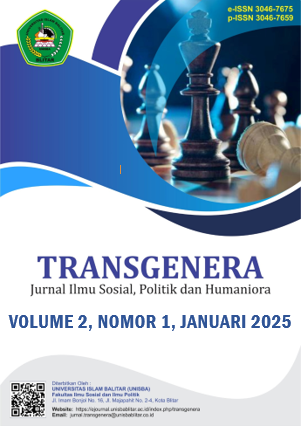Peran Literasi Keuangan Digital dalam Memitigasi Perilaku Doom Spending: A Narrative Literature Review
DOI:
https://doi.org/10.35457/transgenera.v2i1.4150Keywords:
digital financial literacy, doom spending, protection motivation theory, behavior finance theory, theory planned behaviorAbstract
The emergence of the doom spending phenomenon is triggered by anxiety and uncertainty about the future, particularly during crises such as pandemics or economic instability. However, the literature addressing the mitigation of doom spending through digital financial literacy remains very limited. Previous studies have primarily focused on traditional financial literacy without considering its digital components. This article presents a novel approach by integrating digital financial literacy, including access to information, application evaluation, and risk management, as a tool to mitigate doom spending. Using a narrative literature review approach, this study examines the relevance of Behavioral Finance Theory, Protection Motivation Theory, and Theory of Planned Behavior to understand the relationship between digital financial literacy and the transformation of impulsive thinking into rational financial decision-making.
The analysis reveals that digital financial literacy plays a crucial role in enhancing perceived behavioral control, reducing the risks of destructive spending, and strengthening individuals’ financial resilience. This study also recommends longitudinal research to evaluate the long-term impact of digital financial literacy, as well as interdisciplinary explorations integrating social and cultural factors in the mitigation of doom spending. These findings offer significant new insights for policymakers, financial practitioners, and academics to address the challenges of the digital economy in the future.
Downloads
References
Ajzen, I. (1991). The theory of planned behavior. Organizational Behavior and Human Decision Processes, 50(2), 179–211. https://doi.org/10.1016/0749-5978(91)90020-T
Argasasmita, Gita. 17 Oktober 2024. Kenali Fenomena Doom Spending yang Bisa Bikin Miskin Gen Z dan Milenial. https://finansial.bisnis.com/read/20241017/55/1808251/kenali-fenomena-doom-spending-yang-bisa-bikin-miskin-gen-z-dan-milenial.
Azeez, N.P.A., Akhtar, S.M.J.: Digital Financial Literacy and Its Determinants: An Empirical Evidences from Rural India. South Asian J. Soc. Stud. Econ. 11, 8–22 (2021). https://doi.org/10.9734/sajsse/2021/v11i230279.
Beritasatu.com. Selasa, 1 Oktober 2024. 10 Tips Self Reward yang Terhindar dari Doom Spending. https://www.beritasatu.com/ekonomi/2845729/10-tips-self-reward-yang-terhindar-dari-doom-spending
DeHart, W. B., Friedel, J. E., Lown, J. M., & Odum, A. L. (2016). The effects of financial education on impulsive decision making. PLOS ONE, 11(7), e0159561. https://doi.org/10.1371/journal.pone.0159561
Henchoz, C., Coste, T., & Wernli, B. (2019). Culture, money attitudes and economic outcomes. Journal of Economic Psychology, 75, 102-115. https://doi.org/10.1016/j.joep.2019.102115
Kemendikbud. (2024). Meningkatkan Pemahaman, Keterampilan, dan Kemampuan Pengelolaan Keuangan melalui Literasi Finansial, 21 Oktober 2024. Retrived from https://www.kemdikbud.go.id/main/blog/2024/10/meningkatkan-pemahaman-keterampilan-dan-kemampuan-pengelolaan-keuangan-melalui-literasi-finansial
Kompas. 30 September 2024. Gen Z dan Milenial Cenderung Melakukan Doom Spending, Apa Itu?. https://www.kompas.com/tren/read/2024/09/30/113000565/gen-z-dan-milenial-cenderung-melakukan-doom-spending-apa-itu-?page=all.
Koskelainen, T., Kalmi, P., Scornavacca, E., & Vartiainen, T. (2023). Financial literacy in the digital age—A research agenda. Journal of Consumer Affairs, 57(1), 507-528. DOI: 10.1111/joca.12510
Lyons, A.C., Kass‐Hanna, J.: A methodological overview to defining and measuring “digital” financial literacy. Financ. Plan. Rev. (2021). https://doi.org/10.1002/cfp2.1113.
Müller, A., Laskowski, N.M., Wegmann, E., Steins-Loeber, S., Brand, M.: Problematic Online Buying-Shopping: Is it Time to Considering the Concept of an Online Subtype of Compulsive Buying-Shopping Disorder or a Specific Internet-Use Disorder? Curr. Addict. Reports. 8, 494–499 (2021). https://doi.org/10.1007/s40429-021-00395-3.
OECD. (2017). Enhancing financial literacy in the digital age. OECD Publishing. https://doi.org/10.1787/9789264270282-en
Rogers, R. W. (1975). A protection motivation theory of fear appeals and attitude change. Journal of Psychology, 91(1), 93–114. https://doi.org/10.1080/00223980.1975.9915803
Setiawan, M., Effendi, N., Santoso, T., Dewi, V.I., Sapulette, M.S.: Digital financial literacy, current behavior of saving and spending and its future foresight. Econ. Innov. New Technol. 31, 320–338 (2022). https://doi.org/10.1080/10438599.2020.1799142.
Talwar, M., Talwar, S., Kaur, P., Tripathy, N., Dhir, A.: Has financial attitude impacted the trading activity of retail investors during the COVID-19 pandemic? J. Retail. Consum. Serv. 58, 102341 (2021). https://doi.org/10.1016/j.jretconser.2020.102341.
Thaler, R. H. (1985). Mental accounting and consumer choice. Marketing Science, 4(3), 199–214. https://doi.org/10.1287/mksc.4.3.199
Downloads
Published
Issue
Section
License
Authors who publish with this journal agree to the following terms:
- Copyright on any article is retained by the author(s).
- Author grant the journal, right of first publication with the work simultaneously licensed under a Creative Commons Attribution License that allows others to share the work with an acknowledgement of the work’s authorship and initial publication in this journal.
- Authors are able to enter into separate, additional contractual arrangements for the non-exclusive distribution of the journal’s published version of the work (e.g., post it to an institutional repository or publish it in a book), with an acknowledgement of its initial publication in this journal.
- Authors are permitted and encouraged to post their work online (e.g., in institutional repositories or on their website) prior to and during the submission process, as it can lead to productive exchanges, as well as earlier and greater citation of published work.
- The article and any associated published material is distributed under the Creative Commons Attribution-ShareAlike 4.0 International License.














